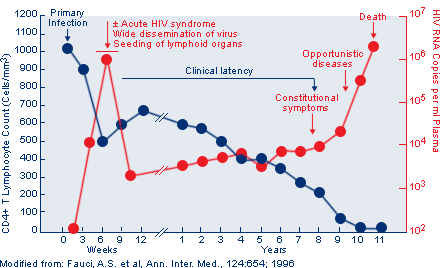About HIV
HIV stands for human immunodeficiency virus. It is a member of a group of viruses called retroviruses. HIV attacks the immune system by destroying CD4 positive T lymphocyte (CD4) cells, a type of white blood cell that is vital to fighting off infection. The destruction of these cells leaves the body susceptible to life-threatening conditions, such as infections or cancers. The number of CD4 cells (the CD4 cell count) is used as a measure of immune function. A lower CD4 cell count indicates a weaker immune system.
AIDS stands for acquired immunodeficiency syndrome and is a combination of diseases that don’t normally appear in people with healthy immune systems. It is the final stage of HIV infection in which the body’s immune system is unable to fight off infections and other illnesses that take advantage of a weakened immune system. A person infected with HIV is diagnosed with AIDS when he or she has one or more of these conditions and/or if he or she has a dangerously low number of CD4 cells (less than 200 cells per cubic millimetre (mm3) of blood).
HIV is a member of a group of viruses called retroviruses. Within the retrovirus family, HIV belongs to a subgroup called lentiviruses, or “slow” viruses. Lentiviruses have a long time period between initial infection and the beginning of serious symptoms. Other similar lentiviruses infect nonhuman species such as feline immunodeficiency virus (FIV) in cats and simian immunodeficiency virus (SIV) in monkeys.
Almost all organisms, including most viruses, store their genetic material in the form of DNA (deoxyribonucleic acid). Retroviruses are the exception as their genes are composed of RNA (ribonucleic acid).After entering (infecting) a CD4 cell, HIV uses an enzyme called reverse transcriptase to convert its RNA into DNA and then uses the CD4 cell's own replication machinery to make copies of the virus. These new virus copies then leave the cell, enter the bloodstream and are ready to infect new cells. Drugs to treat HIV target different stages of this process.
On entering the body, the HIV virus infects a large number of CD4 cells and replicates rapidly. During this acute primary infection, the blood has a high number of HIV copies (viral load) that spread throughout the body, infecting various organs, particularly the lymphoid organs such as the thymus, spleen and lymph nodes, where massive production of virus follows. As a result, during the acute phase of infection, up to 70 percent of HIV-infected people suffer flu-like symptoms.
Two to four weeks after exposure to the virus, the immune system fights back with killer T cells (CD8+ T lymphocyte cells) and B-lymphocyte-cell-produced antibodies. During this time, HIV levels in the blood drop dramatically and CD4 cell counts rebound. However, the resulting immune response to suppress the virus is only partially successful and some virus escapes, hiding and lying dormant in infected cells for months or years.
The HIV-infected person may then enter a period of clinical latency. During this phase a person infected with HIV may remain free of HIV-related symptoms for several years despite the fact that HIV continues to be present within the body.
After a period of time, the immune system deteriorates to the point where the body is unable to fight off other infections and AIDS develops. The HIV viral load in the blood dramatically increases while the number of CD4 cells drop to dangerously low levels (fewer than 200 CD4 cells per mm3 of blood).
The typical relationship between the levels of HIV (viral load) and CD4 cell counts during the course of an untreated HIV infection are outlined in the diagram below:
Figure: clinical progression of HIV

HIV is treated with a combination of HIV medicines (usually three) taken together every day. This is known as combination antiretroviral therapy or cART. Although HIV treatment cannot cure HIV, it prevents HIV from multiplying and thereby reduces the amount of virus in the blood, often to undetectable levels. This in turn reduces the risk of HIV transmission.
There are two types of HIV: HIV-1 and HIV-2. Both types are transmitted by sexual contact, through blood, and from mother to child, and appear to cause clinically indistinguishable AIDS. Type HIV-2, however, seems to be less easily transmitted, and seems to have a slower, less severe clinical course. Worldwide, HIV-1 occurs much more commonly. The relatively uncommon HIV-2 type is found predominately in West Africa.
RNA viral load is the number of copies of HIV-RNA in the blood, which represents the amount of virus (or virus concentration) in the body of an infected person. The viral load and CD4 cell count are used as a measure of the infection’s progress.
A CD4 cell count is a blood test to determine how well the immune system is working in people who have been diagnosed with HIV. A healthy person without HIV has about 500 to 1500 CD4 cells per mm3 blood. Having a low CD4 count increases a person's risk of developing opportunistic infections. Until recently, treatment of persons with HIV without health problems typically started when the number of CD4 cells had decreased below 500 cells per mm3 blood. According to current guidelines, treatment is recommended for all HIV-infected individuals, regardless of CD4 cell count.
More information related to HIV/AIDS can be found via our useful links page.
Sources
- UNAIDS website, www.unaids.org
- National Institute of Allergy & Infectious Diseases website, www.niaid.nih.gov/topics/hivaids
